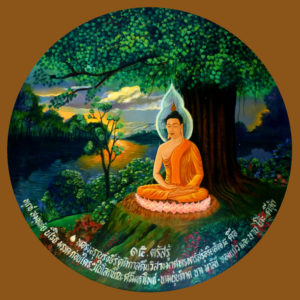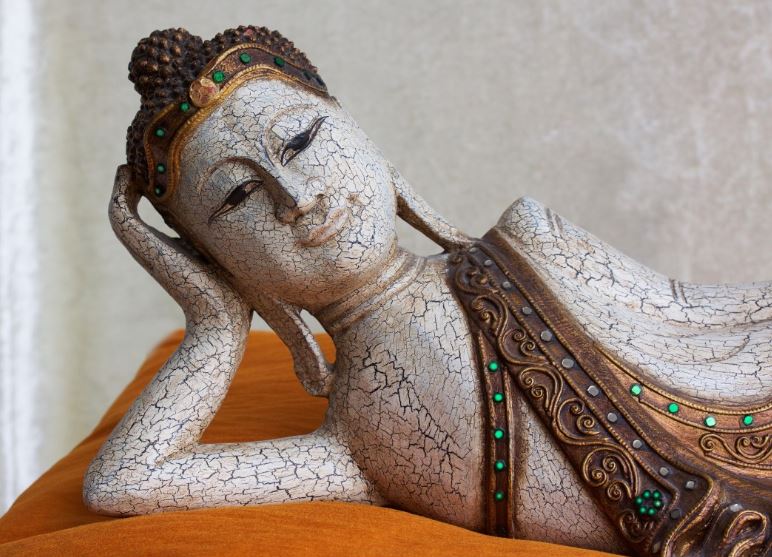Buddhism was born as a religion during the sixth century when a young man named Siddhartha Guatama achieved enlightenment while meditating under a tree. Siddhartha became known as Buddha, or “Enlightened One,” and taught his philosophy for the next 45 years. Today, between 300 and 400 million people worldwide claim to be Buddhist. Since the beginning, Buddhism has also been called “The Middle Way,” and despite its popularity, Buddhism remains somewhat mysterious to many people. Who is Buddha and what is his “Middle Way”?
The year is not exactly known, but possibly around 563 B.C., Siddhartha Guatama was born into a royal family. For the first 29 years of his life, he enjoyed the materialistic and hedonistic trappings that come with life in the upper castes. During the course of his life, he became exposed to the suffering of old age, sickness, and death in the world. He decided to leave his privileged life, and, for the next six years, practiced a form of asceticism known as Jainism. Siddhartha became very disillusioned with the mainstream religion of Hinduism. In his mind, Hinduism had no ethical basis and had become a corrupt system that enabled people to do whatever they pleased, as long as they paid tribute to whichever gods condoned their chosen behavior.
Siddhartha also became repelled by the extreme asceticism of Jainism.
Facing poverty, exposure, starvation, and chastity in the pursuit of inner truth did not seem right to him, either. It is said that he sat down in the shade under a type of fig tree called the Bodhi tree. 
There in the beauty of nature, he resolved not to move until he found the answers he was seeking. By dawn’s first light, after undergoing several temptations and trials, he was Awakened. Buddha waited for 49 days before he taught these truths for fear that people would reject them. Out of compassion for his fellow man, he eventually began to teach his new-found philosophy. His teachings led people down a path that avoided indulgence and hedonism but also avoided the other extreme of deprivation and asceticism; Buddha’s way was “The Middle Way.”
The Middle Way is an effort to maintain balance in one’s life.
For instance, desires can be very harmful to a person. Desires for material possessions or power or immoral things will lead down a path of self-destruction, so Buddha teaches that these desires must be wiped clean. Desire, however, is necessary; without it, you will have no drive to become a better person. A balance between righteous desire and immoral desire must be reached.
The Middle Way described by Buddha is a constant effort to maintain the correct path between the two extremes that exist in every aspect of life. Mankind is strongly drawn to the polar extremes, whether it be materialism or asceticism, sexual promiscuity or chastity, radical environmentalism or total disregard for nature. The way that Buddha taught was a way that transcended these extremes and led to a balanced life that could end suffering.
The core of Buddha’s teachings is “The Four Noble Truths.”
These are the truths that Buddha came to realize upon reaching enlightenment. The first truth is that life is suffering. Whether it be physical suffering or inner suffering, life is full of it. The second truth is that all suffering has a cause. The root of all suffering is desire. The third truth is that suffering can end.
 The way to be freed from suffering is to renounce all desires. The fourth truth is that there is a path to the end of suffering. The path laid out by Buddha is called “The Noble Eightfold Path.” The “Eightfold Path” is a series of actions and ways of looking at things that will lead the follower on the path to enlightenment, avoiding the extremes of indulgence and deprivation. This is “The Middle Way.”
The way to be freed from suffering is to renounce all desires. The fourth truth is that there is a path to the end of suffering. The path laid out by Buddha is called “The Noble Eightfold Path.” The “Eightfold Path” is a series of actions and ways of looking at things that will lead the follower on the path to enlightenment, avoiding the extremes of indulgence and deprivation. This is “The Middle Way.”
While Buddha and his teachings may seem mysterious or strange to some, they have led many others down their own path of enlightenment. In his quest for answers in a world full of suffering, the young prince Siddhartha Guatama found a path of balance in a society of extremes. 2500 years later “The Middle Way” is still embraced by millions of people around the world.





